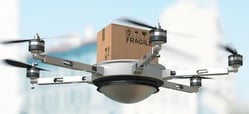Several companies are involved in projects with unmanned aerial vehicles, also called drones. How will the use of drones impact the global transportation industry? Here are a few pros and cons.
In one project in Rwanda, drones are used for delivery of blood and medical supplies throughout the country. As the country is in Central/Eastern Africa it means heavy rains in parts of the year. The country’s roads become almost inaccessible during the rainy season. The drones can continue to work since they are not faced by inclement weather, road hazards and traffic delays. 400 feet above ground and at a speed of 80 mph they will cover two-thirds of Rwanda. The two main problems, speed and spoilage, in the healthcare supply chain are solved with the use of drones.
Truck driver or air pilot?
Another project discussed by parcel delivery companies is the test of drones for residential package delivery.
 The drone is launched from the top of an ordinary delivery truck. The driver can make a delivery while the drone flies away and makes its delivery. After delivery, the drone docks with the truck in a new location. The main benefits would be to save time and reduce costly miles driven.
The drone is launched from the top of an ordinary delivery truck. The driver can make a delivery while the drone flies away and makes its delivery. After delivery, the drone docks with the truck in a new location. The main benefits would be to save time and reduce costly miles driven.
The use of drones in the transportation industry is still in its infancy. But, as the technology evolves it will most likely become used in a wider perspective. How will it be used, you ask?
A few of the pros and cons might give us a hint.
Pros
- It is fast in situations where roads are bad or jammed.
- It saves time since it can take the shortest way and let a driver continue with other deliveries.
- It saves fuel hence it is good for the environment.
Cons
- It requires investments in new technology and/or adaption of existing vehicles, which could be costly.
- Flight restrictions might limit the use.
- The drone can only take limited loads.
The load limit makes this solution available for light weight packages only. But, in big cities with traffic congestions, where might take hours to travel a few miles, this could be an alternative to trucks. The environmental effects are also beneficial to congested big cities. Or, as in the Rwanda case where the roads don’t even exist parts of the year.
So, back to the question; will you be replaced by a drone? For the main part of the transportation industry the answer is probably no. Someone must control the drone and make it work. In the package delivery above the drone serves as a complement to the driver. And, even though technology will evolve, a full replacement of humans with automation is still far away. But, it is a technology well worth keeping an eye on.
Mark Wallace, senior president of global engineering and sustainability at UPS says at truck.com:
“Drivers are the face of our company, and that won’t change,” ... “What’s exciting is the potential for drones to aid drivers at various points along their routes, helping them save time and deliver on increasing customer service needs that stem from the growth of e-commerce”.
For us still bound to the ground, there are devices facilitating traditional transportation when driving conditions are bad (like Onspot, for example) helping to make deliveries on time. And, hopefully the good old lorry will stay competitive for yet a while.


